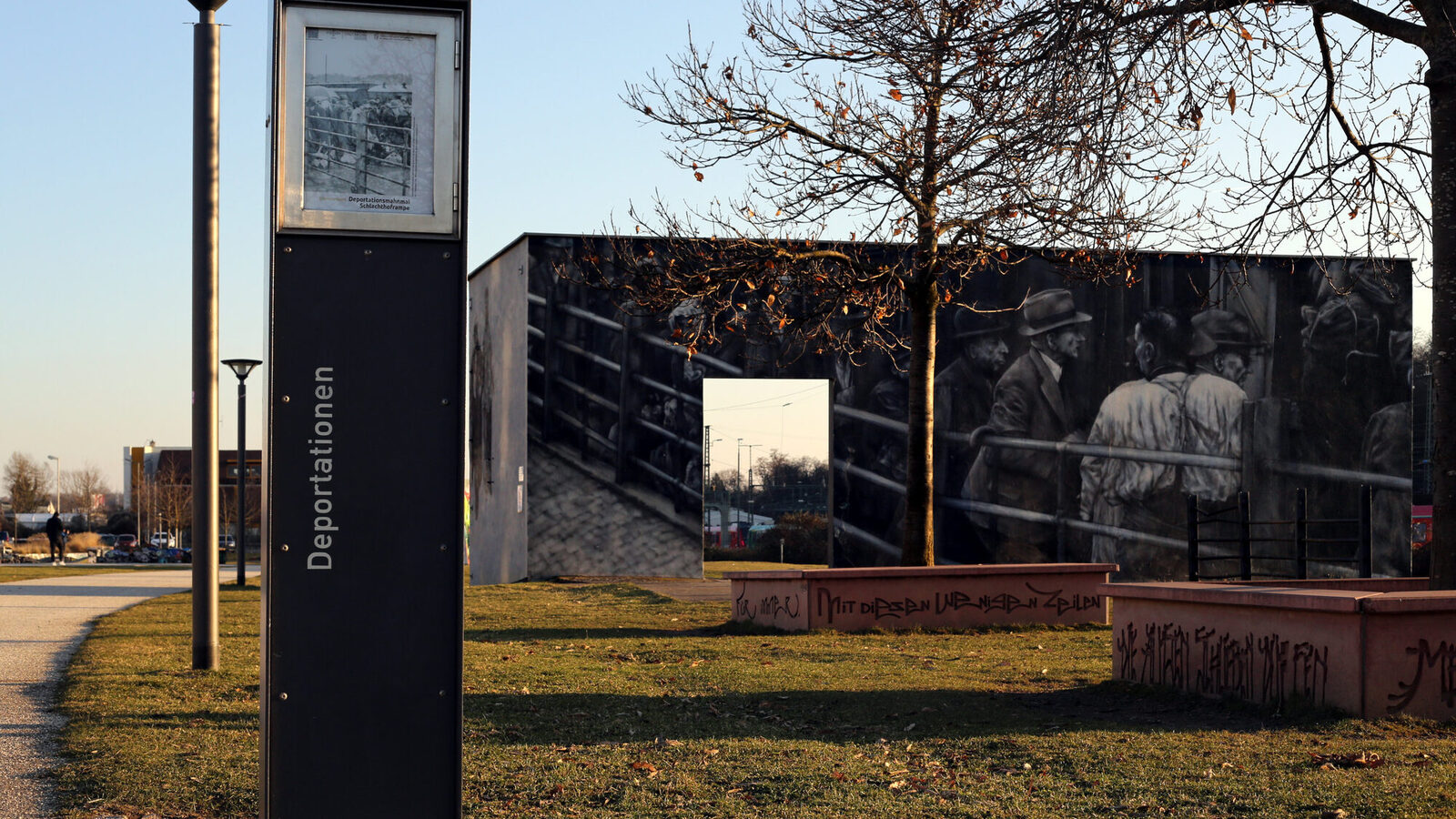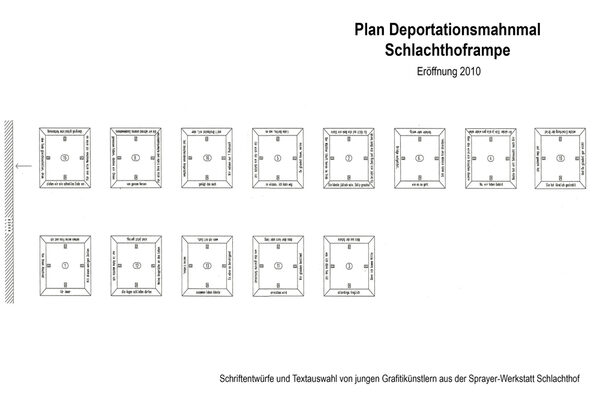Slaughterhouse ramp deportation memorial
Along the former cattle loading ramp of the former municipal abattoir is a multi-part memorial ensemble that commemorates the large-scale deportations of Wiesbaden Jews in 1942.
Concept of the memorial
The memorial is made up of various installations. At the center are two photorealistic depictions created by Wiesbaden graffiti artist Yorkar7 in 2007 on the remains of a wall of an otherwise demolished building of the former Fauth company. They are based on images from a historical photo series showing the last large-scale deportation of Wiesbaden Jews on September 1, 1942. The approximately 370 mostly older members of the Jewish community who were deported on this day alone had already had to report to the synagogue in Friedrichstraße and register on August 29.
The large-scale deportation painting on the north side of the remains of the wall is clearly visible from a distance. It shows a group of people boarding a passenger wagon, in which they were first taken to the Theresienstadt concentration camp via Frankfurt am Main. On the side wall of the remnant of the wall, Yorkar7 took over a section of another image from the picture series. It shows an elderly Jew from Wiesbaden who has to be supported by a helper. The so-called Jewish star, which Jews had to wear from 1941, can be clearly seen on his coat. Most of the Wiesbaden residents deported on this day did not survive the concentration and extermination camps.
Since 2010, the pictorial documents have been supplemented by an avenue of chestnut trees designed by Frankfurt multimedia artist Vollrad Kutscher. This leads in a north-south direction directly to the large deportation graffito. Fragments of text are embedded on the four sides of the planters, which also serve as seating. Among other things, they come from farewell letters from Wiesbaden residents who were deported on September 1, 1942. Together with Kutscher and Yorkar7, some younger Wiesbaden sprayers developed completely new, different lettering for each quotation.
The photo series
The photo series, which served as a model for the graffiti, was given to the Wiesbaden City Archive and other institutions in Wiesbaden by Richard Rudolph. The Yad Vashem memorial had already received an initial donation of 17 images in 1980. The history of the photo series has not yet been fully researched. What is known so far is that 38 photographs have been preserved. From various angles, the camera accompanies mainly older Jews on their journey between August 29 and September 1, 1942. Some shots show the registration process at the Jewish Community Center in Wiesbaden's Friedrichstraße. Another picture documents the situation in the synagogue, which was set on fire during the November pogroms but not destroyed. The Wiesbaden residents had to wait in the large empty room after registration until they were deported. The majority of the photos show the Jews being processed at the slaughterhouse ramp until they boarded the wagons in which they were deported to Theresienstadt via Frankfurt am Main.
It has not yet been possible to establish who took the photos and how they reached memorial institutions such as the City Archive and the Spiegelgasse Active Museum of German-Jewish History via various routes. It is also not known where the negative strips are located.
Deportations of Jews from Wiesbaden
Literature
Further information
City archive
Address
65197 Wiesbaden
Postal address
65029 Wiesbaden
Arrival
Notes on public transport
Public transportation: Bus stop Kleinfeldchen/Stadtarchiv, bus lines 4, 17, 23, 24 and 27 and bus stop Künstlerviertel/Stadtarchiv, bus line 18.
Telephone
- +49 611 313022
- +49 611 313977
Opening hours
Opening hours of the reading room:
- Monday: 9 a.m. to 12 p.m.
- Tuesday: 9 am to 4 pm
- Wednesday: 9 am to 6 pm
- Thursday: 12 to 16 o'clock
- Friday: closed


